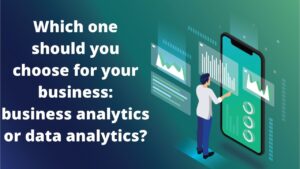Data analytics is a technique of gathering data and then reviewing it for the purpose of extracting useful information that may be hidden. It encompasses processes and tools in the aggressive analysis of raw data, converting it into insightful information for use in decision-making. This tutorial will guide you, a complete novice in data analytics, by explaining these terms as well as how to do it.
1. What is Data Analytics?
Definition:
Data analysis is the process of using an algorithm to derive information from raw data to reach conclusions as to that information. It entails the use of complex mathematical algorithms and models to allow for the identification of relationships, tendencies and other important hidden qualities.
Importance:
Business intelligence provides insights and strategies to manage organizational tasks, drive efficiency, enrich customer experiences, and succeed in the market.
2. Types of Data Analytics
Data analytics can be categorized into four main types, each serving a different purpose:Data analytics can be categorized into four main types, each serving a different purpose:
1. Descriptive Analytics
• Purpose: Does this by briefly recounting history as a means of explaining what happened in the past in an interpretable manner.
• Examples: Reports on sales, website visitors and traffic, and balance sheets among others.
2. Diagnostic Analytics
• Purpose: Instead, endeavours to uncover factors and relationships that may have caused prior performance.
• Examples: A case of exploratory trouble-shooting of a decline in sales, understanding customer attrition factors.
3. Predictive Analytics
• Purpose: Makes predictions and estimates about the future results dependent on past occurrence and mathematical analysis.
• Examples: Its common uses includes sales forecast, trend analysis of customers’ buying behaviors, and risk appraisal.
4. Prescriptive Analytics
• Purpose: Helps the end users to come up with the right strategies and courses of actions that will lead to the intended goals and has an added feature of the forecast of the future patterns.
• Examples: Marketing planning and adjustment for maximum effectiveness, suggestions concerning stock balance indication.
3. The Data Analytics Process
The data analytics process typically involves several key steps:The data analytics process typically involves several key steps:
1. Data Collection
• Description: Data acquisition from multiple sources including such as databases, API’s, surveys, web scraping, etc.
• Tools: A hold of SQL, Python, Excel.
2. Data Cleaning
• Description: The process of editing records with a purpose of eradicating or improving the existing data with view to improve quality.
• Tools: csv, Python (pandas), Excel, OpenRefine.
3. Data Exploration
• Description: Carrying out EDA to estimate the nature of the data and its distribution, as well as relationships present between variables.
• Tools: Python (pandas, Matplotlib, Seaborn), R.
4. Data Analysis
• Description: Using quantitative analytical tools to make assertions about presented data and patterns to arrive at trends and conclusions.
• Tools: Statistical Packages: SPSS, SAS, python with SciPy, Scikit learn, R.
5. Data Visualization
• Description: Using maps and diagrams as a way of conveying the collected information and results.
• Tools: There are many tools, but the most popular ones include Tableau, Microsoft Power BI, Python with Libraries like Matplotlib and Seaborn, R with ggplot2.
6. Reporting
• Description: In this process, synthesize the analysis results into reports and dashboard for the stakeholders to make the necessary bookings.
• Tools: BI tools include the likes of Tableau business intelligence tool, Power BI and the excel business-intelligence tool.
The following are major concepts in Data Analytics.
1. Statistical Analysis
• Description: A branch of mathematical and logical techniques, procedures, technologies and methods to condense, characterize and extrapolate from data.
• Examples: Arithmetic mean, median, standard deviation, coefficient of correlation, regression coefficient.
2. Data Mining
• Description: The interaction of machine learning and statistical methods with big data for extracting the patterns and knowledge existing in it.
• Examples: Grouping, categorization, market basket analysis.
3. Machine Learning
• Description: Applying methods of employing mathematical tools to make computerized analyses and decisions based on the specified data samples.
• Examples: There are two categories in Machine learning these are supervised and unsupervised learning; in supervised learning the applications are regression, classification while in the unsupervised learning applications include clustering or association.
4. Big Data
• Description: Processing of massive and complicated data that cannot be processed by tools of ordinary data processing.
• Tools: Big data processing tools like Hadoop, big data processing engine Spark, NoSQL data store.
5. Tools and Technologies
1. Excel
• Use: Then, through data cleaning, analysis and visualization, the results generated from this study could be obtained.
• Strengths: Very acommodative, popular, great on small data set.
2. SQL
• Use: Database interrogation, and controlling and monitoring structured databases.
• Strengths: somewhat improved and efficient in data retrieval and manipulation.
3. Python
• Use: Data manipulation, analysis, machine learning and data visualization.
• Strengths: Flexible and comprehensive to most areas of data analysis (pandas, NumPy, SciPy, Scikit-learn, Matplotlib).
4. R
• Use: Statistics and computer-data graphics.
• Strengths: Fast numeric OOP, broad graphic toolkits/ggs or ggplot2.
5. Tableau
• Use: The major subject matter includes data visualization and dashboard.
• Strengths: Supports the interactive view and the sharing of findings, simple design.
6. Power BI
• Use: Some of the specific functions that fall under the concept of business intelligence are business analytics and reporting, data mining, data visualization, and dashboarding.
• Strengths: Compliance with Microsoft products, infographics and financial charts.
6. Introduction to Data Analytics
1. Learn the Basics
• Courses: Take the first level or entry level courses on Coursera, edx, Udacity and Khan Academy and many others.
• Books: The recommended book by the tutors are; “Data Science for Business” by Foster Provost, and Tom Fawcett “Python for Data Analysis” by Wes McKinney.
2. Develop Technical Skills
• Programming: These programming languages may be learned for data analysis: Python or R.
• SQL: Learn Basics of SQL for Structured Query Language and query databases.
• Visualization: You should gain some knowledge about such programs as Tableau or Power BI.
3. Gain Practical Experience
• Projects: To practice, find data analysis related real life projects to work on.
• Internships: Find jobs as interns or as junior data analysts.
4. Stay Updated
• Blogs: Consult the following sites and blogs: Towards Data Science, DataCamp, KDnuggets.
• Communities: Be active on social platforms such as Reddit data science page or r/datascience, Kaggle and Stack overflow.
Conclusion
Business intelligence is a strong discipline that can generate large value when properly implemented. Knowing the basics, learning tools, and techniques and getting some practical experience, it is possible to begin a successful career in data analysis. Consistency in one’s work and trying to remain as updated as possible with the advances in the field would guarantee that one remains relevant in the career path.
Resources – Top Data Analytics Course Training Institutes in Bangalore
Simplilearn – Data Analytics course in bangalore
AnalyticsLabs – Best Data Analytics Training in Bangalore
360DigiTMG – Top Data Analytics Offline Course Institute in Bangalore
Fita Academy – Data Analytics Training in Bangalore
Learnbay Data Analytics Course in Bangalore
Other resources:
https://360digitmg.com/india/bangalore/data-analytics-certification-course-training-institute
https://www.mastersindatascience.org/learning/what-is-data-analytics/
https://www.geeksforgeeks.org/what-is-data-analytics/
https://www.comptia.org/content/guides/what-is-data-analytics


